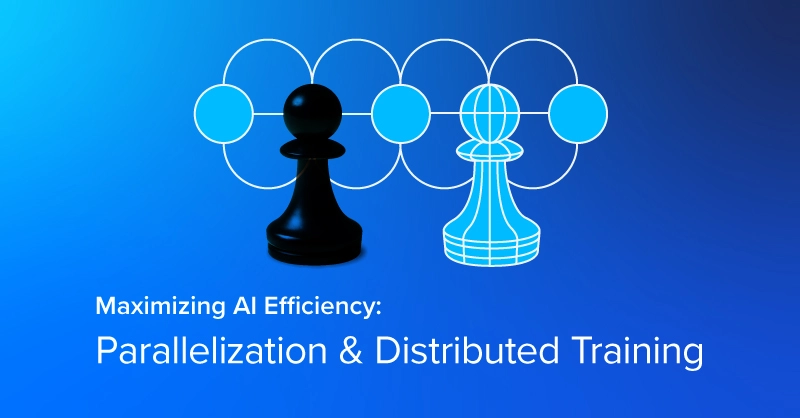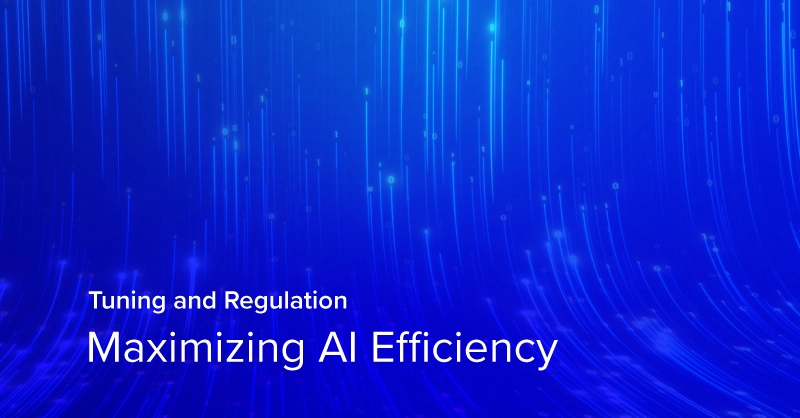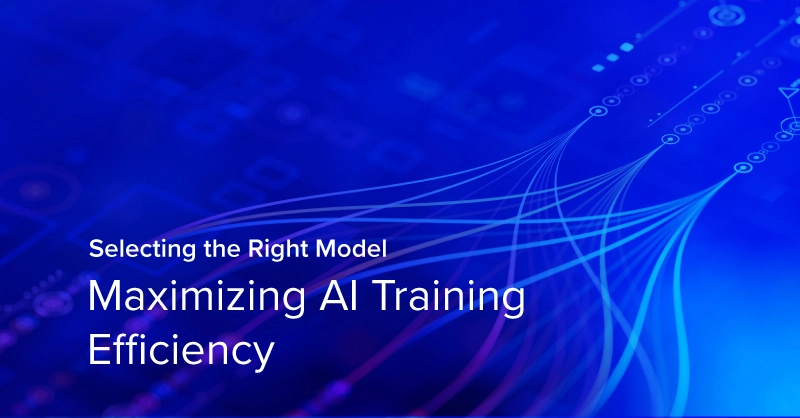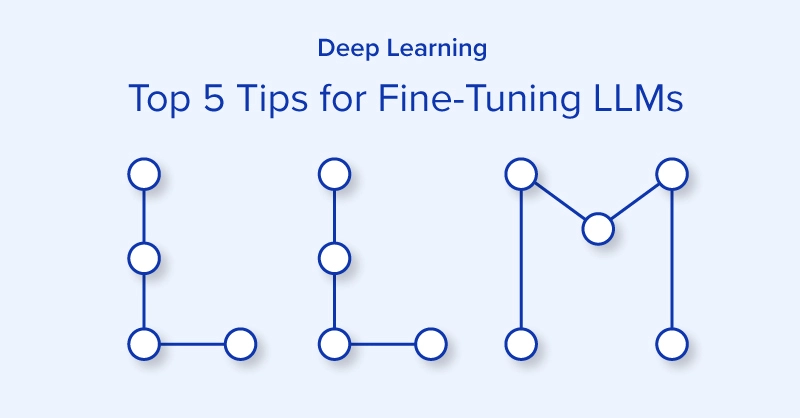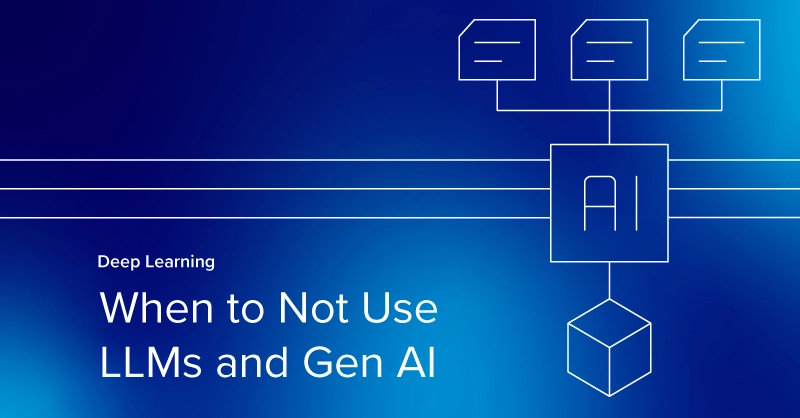
Generative AI isn't Always the Answer
Over the years Deep Learning and Artificial Intelligence have become synonymous with Generative AI and Large Language Models. Its ubiquity has caused any mention of AI to equal GenAI and LLMs dominating the conversations. The groundbreaking capabilities and impact on innovation in language models and creative AI should not be discounted.
While their capabilities are far-reaching, we can’t help but recognize some use cases where generative AI is ineffective. The classic, good old, deep learning AI, machine learning, or rule-based algorithms may seem like a better fit.
What Generative AI and LLMs Are Good At?
GenAI and LLMs excel at text generation, summarization, conversational AI, knowledge discovery, and other cases where the data it was trained on can be offered to the user in a more digestible output. Another way to think about GenAI and LLMs is like encyclopedias that have a wealth of information that can be fed back to you when prompted.
But with so much knowledge, GenAI and LLMs can sometimes get confused between different topics. This is why Retrieval Augmented Generation can supercharge Generative AI to develop better responses just by providing added context to the initial prompt.
However, because GenAI is creating unique responses by referencing its knowledge base or training data, they aren’t the best choice for every problem, especially workloads that require precision or reasoning.
3 Use Cases Where Generative AI Wouldn’t Be the Best Choice
Generative AI is great for generating text, explaining topics, and summarizing but struggles with precisions, data relationships, forecasting, and more. We will go over a couple of common AI use cases where GenAI would not be the primary engine and provide which machine learning methodologies would better suit the task at hand.
Data Analysis for Business Intelligence
In structured data analysis, the ability to manually or automatically engineer features is crucial which are essential for using AI to make business decisions through forecasting, planning, and decision making. Features are specific attributes or variables that influence the output or decision.
Why Generative AI is Not Ideal for Data Analysis and Forecasting:
- Numerical Precision: Data analysis requires accurate numerical predictions based on historical data. Generative AI, which is better suited for content creation, may lack the precision needed for making reliable quantitative forecasts.
- Temporal Dependencies & Optimization: Forecasting often involves understanding temporal patterns and trends over time so models like ARIMA (Autoregressive Integrated Moving Average), LSTM (Long Short-Term Memory), and other time-series models are specifically designed to capture these temporal dependencies, which generate models are not optimized for. Planning and Decision Making involves optimization algorithms where GenAI just isn't good enough in derivatives and math to be effective enough.
- Interpretability and Consistency: In data analysis, especially in fields like finance or operations, the ability to interpret and explain predictions is critical. Traditional forecasting models provide more consistent and interpretable results, while generative models can introduce unnecessary variability.
In planning and decision-making, optimization problems are common, such as maximizing revenue, minimizing costs, or efficiently allocating resources. While LLMs can analyze patterns in text data, they aren't optimized for detecting or exploiting such relationships within structured data. Read Snap Finance utilize Machine Learning to differentiate their credit assessment for consumer financing:
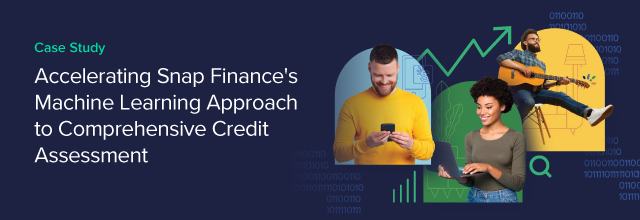
Data analysis and forecasting tasks require models with strong numerical accuracy, an understanding of temporal trends, and clear interpretability, making ARIMA, LSTM, and other specialized models more suitable than generative AI.
Segmentation and Classification
Segmentation and classification tasks are typically better suited to Convolutional Neural Networks (CNNs) for image data or decision trees and support vector machines (SVMs) for structured data. These models excel at recognizing patterns and differentiating between categories in a precise and structured manner.
Why Generative AI is Not Ideal for Segmentation and Classification:
- Precision and Boundary Detection: Segmentation and classification tasks require precise identification of boundaries and clear distinctions between classes. Generative AI, which focuses on creating new content, may introduce variability or lack the sharpness needed for these tasks.
- Task-Specific Optimization: CNNs are specifically designed for tasks like image segmentation and classification, optimizing for accuracy in distinguishing between different segments or classes. Generative models are not tailored for this level of specificity.
- Interpretability and Consistency: Segmentation and classification often require clear, interpretable results. Generative models can be less consistent and more prone to producing ambiguous outputs, which is not ideal when the goal is to categorize or segment data reliably.
You may wonder why you can task an LLM chatbot to identify objects within an image. GenAI is not the primary engine but instead employs a computer vision model to make its predictions and feed the data back to the chatbot which then generates an output response.
While generative models can produce outputs that resemble the input data, they are not optimized for tasks that require clear boundaries between classes or segments. Their focus on generation rather than discrimination can lead to less accurate or interpretable results in segmentation and classification scenarios.
Recommendation Systems
Recommender systems are typically better suited to algorithms specifically designed for analyzing user-item interactions, such as collaborative filtering, content-based filtering, or matrix factorization techniques. These methods are optimized to predict user preferences by identifying patterns and similarities in large datasets of user behavior and item attributes.
Why Generative AI is Not Ideal for Recommender Systems:
- Precision and Specificity: Recommender systems require precise matching between user preferences and items. Generative AI models, which are designed to create or generate new content, may introduce variability or noise that could reduce the accuracy of recommendations.
- Scalability and Efficiency: Recommender systems often need to scale to millions of users and items, where efficiency is key. Traditional recommendation algorithms are optimized for this scale, while generative models can be more resource-intensive.
- Data Structure: Recommender systems work best with structured data (e.g., user ratings, and purchase history), where algorithms can leverage patterns and correlations. Generative AI models are not inherently designed to handle this type of structured, tabular data as efficiently.
In summary, while generative AI can be used for tasks like generating personalized content or product descriptions, traditional recommendation algorithms like collaborative filtering, matrix factorization, or hybrid models are generally more effective for providing accurate and efficient recommendations based on user-item interactions.
Conclusions
Generative AI and LLMs while being the hottest topic in the world of AI, it isn't the only AI we should be paying attention to. Traditional machine learning models and algorithms where data can be collected and used to make predictions would always best be suited for a specialized model.
However, to distribute this data and present it, GenAI and LLMs can help wrap findings up into digestible text. The world is built on words and text, thus translating intricate data relationships into a comprehensible summary can save time and increase productivity.
When talking with our customers about AI and their use case, we ask questions regarding their perspective on Generative AI and LLMs. Snap Finance, a fintech company for credit assessment, deploys machine learning algorithms to evaluate the risk of borrowers taking in factors other than credit score. Since the workload hinges on temporal dynamics and data relationships, LLMs and GenAI wouldn't be suitable
Here are some scoping questions for you to ask when deciding whether Generative AI is a suitable model:
- Does the result require consistency and precision?
- Do you need to perform any optimizations?
- Do you require defined rules for how to read/interpret data
- Is your model responsible for making data-educated conclusions
Whether it's running a Generative AI or LLM model or any other AI algorithm, having a robust computing infrastructure is imperative for smooth operation. Just like choosing the right model for training an AI model or developing and machine learning algorithm, choose the right hardware that fits your budget and needs.

Fueling Innovation with an Exxact Multi-GPU Server
Training AI models on massive datasets can be accelerated exponentially with the right system. It's not just a high-performance computer, but a tool to propel and accelerate your research.
Configure Now
When to Not Use LLMs and Gen AI
Generative AI isn't Always the Answer
Over the years Deep Learning and Artificial Intelligence have become synonymous with Generative AI and Large Language Models. Its ubiquity has caused any mention of AI to equal GenAI and LLMs dominating the conversations. The groundbreaking capabilities and impact on innovation in language models and creative AI should not be discounted.
While their capabilities are far-reaching, we can’t help but recognize some use cases where generative AI is ineffective. The classic, good old, deep learning AI, machine learning, or rule-based algorithms may seem like a better fit.
What Generative AI and LLMs Are Good At?
GenAI and LLMs excel at text generation, summarization, conversational AI, knowledge discovery, and other cases where the data it was trained on can be offered to the user in a more digestible output. Another way to think about GenAI and LLMs is like encyclopedias that have a wealth of information that can be fed back to you when prompted.
But with so much knowledge, GenAI and LLMs can sometimes get confused between different topics. This is why Retrieval Augmented Generation can supercharge Generative AI to develop better responses just by providing added context to the initial prompt.
However, because GenAI is creating unique responses by referencing its knowledge base or training data, they aren’t the best choice for every problem, especially workloads that require precision or reasoning.
3 Use Cases Where Generative AI Wouldn’t Be the Best Choice
Generative AI is great for generating text, explaining topics, and summarizing but struggles with precisions, data relationships, forecasting, and more. We will go over a couple of common AI use cases where GenAI would not be the primary engine and provide which machine learning methodologies would better suit the task at hand.
Data Analysis for Business Intelligence
In structured data analysis, the ability to manually or automatically engineer features is crucial which are essential for using AI to make business decisions through forecasting, planning, and decision making. Features are specific attributes or variables that influence the output or decision.
Why Generative AI is Not Ideal for Data Analysis and Forecasting:
- Numerical Precision: Data analysis requires accurate numerical predictions based on historical data. Generative AI, which is better suited for content creation, may lack the precision needed for making reliable quantitative forecasts.
- Temporal Dependencies & Optimization: Forecasting often involves understanding temporal patterns and trends over time so models like ARIMA (Autoregressive Integrated Moving Average), LSTM (Long Short-Term Memory), and other time-series models are specifically designed to capture these temporal dependencies, which generate models are not optimized for. Planning and Decision Making involves optimization algorithms where GenAI just isn't good enough in derivatives and math to be effective enough.
- Interpretability and Consistency: In data analysis, especially in fields like finance or operations, the ability to interpret and explain predictions is critical. Traditional forecasting models provide more consistent and interpretable results, while generative models can introduce unnecessary variability.
In planning and decision-making, optimization problems are common, such as maximizing revenue, minimizing costs, or efficiently allocating resources. While LLMs can analyze patterns in text data, they aren't optimized for detecting or exploiting such relationships within structured data. Read Snap Finance utilize Machine Learning to differentiate their credit assessment for consumer financing:

Data analysis and forecasting tasks require models with strong numerical accuracy, an understanding of temporal trends, and clear interpretability, making ARIMA, LSTM, and other specialized models more suitable than generative AI.
Segmentation and Classification
Segmentation and classification tasks are typically better suited to Convolutional Neural Networks (CNNs) for image data or decision trees and support vector machines (SVMs) for structured data. These models excel at recognizing patterns and differentiating between categories in a precise and structured manner.
Why Generative AI is Not Ideal for Segmentation and Classification:
- Precision and Boundary Detection: Segmentation and classification tasks require precise identification of boundaries and clear distinctions between classes. Generative AI, which focuses on creating new content, may introduce variability or lack the sharpness needed for these tasks.
- Task-Specific Optimization: CNNs are specifically designed for tasks like image segmentation and classification, optimizing for accuracy in distinguishing between different segments or classes. Generative models are not tailored for this level of specificity.
- Interpretability and Consistency: Segmentation and classification often require clear, interpretable results. Generative models can be less consistent and more prone to producing ambiguous outputs, which is not ideal when the goal is to categorize or segment data reliably.
You may wonder why you can task an LLM chatbot to identify objects within an image. GenAI is not the primary engine but instead employs a computer vision model to make its predictions and feed the data back to the chatbot which then generates an output response.
While generative models can produce outputs that resemble the input data, they are not optimized for tasks that require clear boundaries between classes or segments. Their focus on generation rather than discrimination can lead to less accurate or interpretable results in segmentation and classification scenarios.
Recommendation Systems
Recommender systems are typically better suited to algorithms specifically designed for analyzing user-item interactions, such as collaborative filtering, content-based filtering, or matrix factorization techniques. These methods are optimized to predict user preferences by identifying patterns and similarities in large datasets of user behavior and item attributes.
Why Generative AI is Not Ideal for Recommender Systems:
- Precision and Specificity: Recommender systems require precise matching between user preferences and items. Generative AI models, which are designed to create or generate new content, may introduce variability or noise that could reduce the accuracy of recommendations.
- Scalability and Efficiency: Recommender systems often need to scale to millions of users and items, where efficiency is key. Traditional recommendation algorithms are optimized for this scale, while generative models can be more resource-intensive.
- Data Structure: Recommender systems work best with structured data (e.g., user ratings, and purchase history), where algorithms can leverage patterns and correlations. Generative AI models are not inherently designed to handle this type of structured, tabular data as efficiently.
In summary, while generative AI can be used for tasks like generating personalized content or product descriptions, traditional recommendation algorithms like collaborative filtering, matrix factorization, or hybrid models are generally more effective for providing accurate and efficient recommendations based on user-item interactions.
Conclusions
Generative AI and LLMs while being the hottest topic in the world of AI, it isn't the only AI we should be paying attention to. Traditional machine learning models and algorithms where data can be collected and used to make predictions would always best be suited for a specialized model.
However, to distribute this data and present it, GenAI and LLMs can help wrap findings up into digestible text. The world is built on words and text, thus translating intricate data relationships into a comprehensible summary can save time and increase productivity.
When talking with our customers about AI and their use case, we ask questions regarding their perspective on Generative AI and LLMs. Snap Finance, a fintech company for credit assessment, deploys machine learning algorithms to evaluate the risk of borrowers taking in factors other than credit score. Since the workload hinges on temporal dynamics and data relationships, LLMs and GenAI wouldn't be suitable
Here are some scoping questions for you to ask when deciding whether Generative AI is a suitable model:
- Does the result require consistency and precision?
- Do you need to perform any optimizations?
- Do you require defined rules for how to read/interpret data
- Is your model responsible for making data-educated conclusions
Whether it's running a Generative AI or LLM model or any other AI algorithm, having a robust computing infrastructure is imperative for smooth operation. Just like choosing the right model for training an AI model or developing and machine learning algorithm, choose the right hardware that fits your budget and needs.

Fueling Innovation with an Exxact Multi-GPU Server
Training AI models on massive datasets can be accelerated exponentially with the right system. It's not just a high-performance computer, but a tool to propel and accelerate your research.
Configure Now
